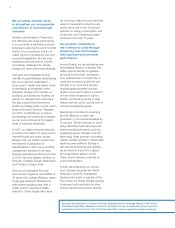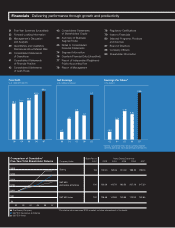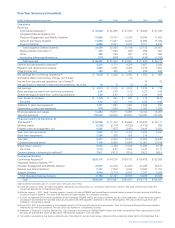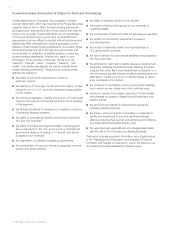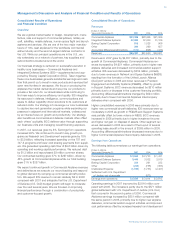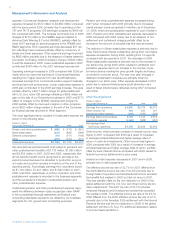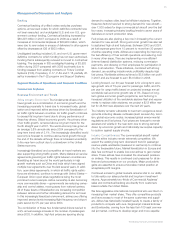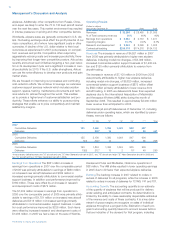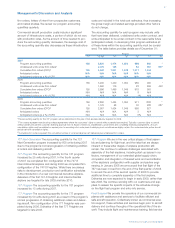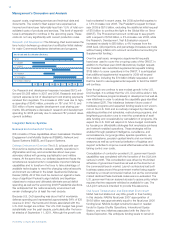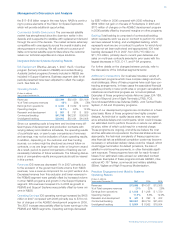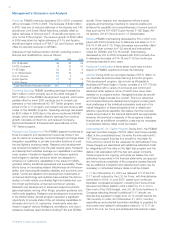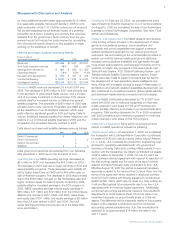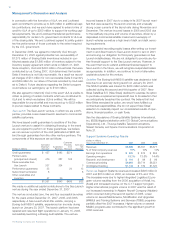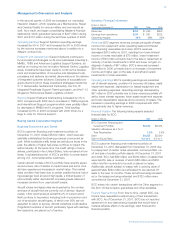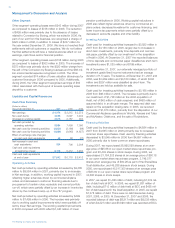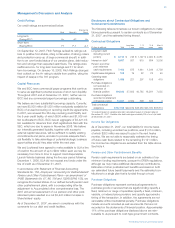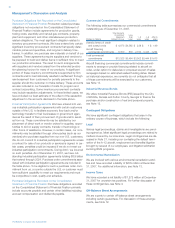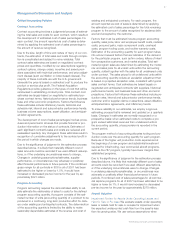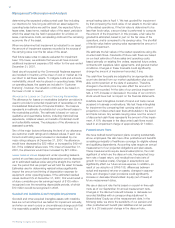Boeing 2007 Annual Report Download - page 31
Download and view the complete annual report
Please find page 31 of the 2007 Boeing annual report below. You can navigate through the pages in the report by either clicking on the pages listed below, or by using the keyword search tool below to find specific information within the annual report.
28
Management’s Discussion and Analysis
support costs, engineering services and technical data and
documents. The costs for fleet support are expensed as
incurred and have been historically less than 1.5% of total con-
solidated costs of products and services. This level of expendi-
tures is anticipated to continue in the upcoming years. These
costs do not vary significantly with current production rates.
Research and Development The following chart summarizes the
time horizon between go-ahead and certification/initial delivery
for major Commercial Airplanes derivatives and programs.
787-8
777-300ER
777-200LR
777-F
747-400BCF
747-8 Freighter
747-8 Intercontinental
Go-ahead and Certification/Delivery
02 03 04 05 06 07 08 09 10
Our Research and development expense increased $572 mil-
lion and $1,088 million in 2007 and 2006. Research and devel-
opment expense is net of development cost sharing payments
received from suppliers. The increase in 2007 was due to high-
er spending of $542 million, primarily on 787 and 747-8, and
$30 million of lower supplier development cost sharing pay-
ments. We anticipate a decrease in research and development
spending for 2008 primarily due to reduced 787 product devel-
opment activities.
Integrated Defense Systems
Business Environment and Trends
IDS consists of three capabilities-driven businesses: Precision
Engagement and Mobility Systems (PE&MS), Network and
Space Systems (N&SS), and Support Systems.
Defense Environment Overview The U.S. is faced with con-
tinuous force deployments overseas, stability operations in
Afghanistan and Iraq, and uncertainties about near-peer
adversary states with growing sophistication and military
means. At the same time, our defense department faces the
simultaneous requirements to recapitalize important defense
capabilities and to transform the force to take advantage of
available technologies to meet the changing national security
environment as outlined in the latest Quadrennial Defense
Review (QDR). All of this must be carried out against a back-
drop of significant Federal budget deficits and bipartisan
objectives to reduce and ultimately eliminate annual deficit
spending as well as the upcoming 2008 Presidential elections.
We anticipate that the national security environment will
remain challenging for at least the next decade.
Because U.S. DoD spending was about half of worldwide
defense spending and represented approximately 84% of IDS
revenue in 2007, the trends and drivers associated with the
U.S. DoD budget are critical. The U.S. DoD budget has grown
substantially over the past decade, particularly after the terror-
ist attacks of September 11, 2001. Although the growth rate
had moderated in recent years, the 2009 submittal equates to
a 7.5% increase over 2008. The President’s request for fiscal
year 2009 is $515 billion, excluding the additional initial request
of $70 billion to continue the fight in the Global War on Terror
(GWOT). The Procurement account continues to see growth
with a request of $104 billion, a 5% increase over 2008, while
the Research, Development, Test & Evaluation account
increased modestly to $80 billion, a 4% increase from the
2008 level. (All projections and percentage increases are made
without taking inflation into account and without accounting for
Supplemental funding.)
Over the past years, emergency supplemental requests
have been used to cover the on-going costs of the GWOT. In
addition to the fiscal year 2008 discretionary budget request,
the President also submitted supplemental requests totaling
$189 billion to cover operations in the GWOT. It is anticipated
that additional supplemental requests for 2009 will exceed
$100 billion, including the $70 billion initially requested, and
that the trend to use supplemental requests to fund the GWOT
will continue.
Even though we continue to see modest growth in the U.S.
DoD budget, it is unlikely that the U.S. DoD will be able to fully
fund the hardware programs already in development as well as
new initiatives in order to address the capability gaps identified
in the latest QDR. This imbalance between future costs of
hardware programs and expected funding levels is not uncom-
mon in the U.S. DoD and is routinely managed by internally
adjusting priorities and schedules, restructuring programs, and
lengthening production runs to meet the constraints of avail-
able funding and occasionally by cancellation of programs. We
expect the U.S. DoD will respond to future budget constraints
by focusing on affordability strategies that emphasize jointness
and network-enabled operations. These strategies will be
enabled through persistent intelligence, surveillance, and
reconnaissance, long-range strike, special operations, un-
manned systems, precision guided kinetic and non-kinetic
weapons as well as continued privatization of logistics and
support activities to improve overall effectiveness while main-
taining control over costs.
Consolidation of contractor-provided U.S. government launch
capabilities was completed with the formation of the ULA joint
venture in 2006. This consolidation was driven by the limited
schedule of government launches as well as the downturn in
the commercial launch market. Launch contractors had built
business cases around the government market being supple-
mented by a robust commercial market, but as the commercial
market declined these business cases were re-evaluated. The
U.S. government has an assured access to space policy which
requires that two separate vehicles be available for use. The
ULA joint venture is intended to provide this assurance.
Civil Space Transportation and Exploration Environment
NASA has had stable but very little growth in their funding
in this decade. NASA’s fiscal year 2007 appropriation of
$16.6 billion was approximately equal to the fiscal year 2006
funding level. NASA’s budget remains focused on needed
funds for Space Shuttle Operations, International Space
Station, and new initiatives associated with the Vision for
Space Exploration. We anticipate funding levels to remain in
The Boeing Company and Subsidiaries


